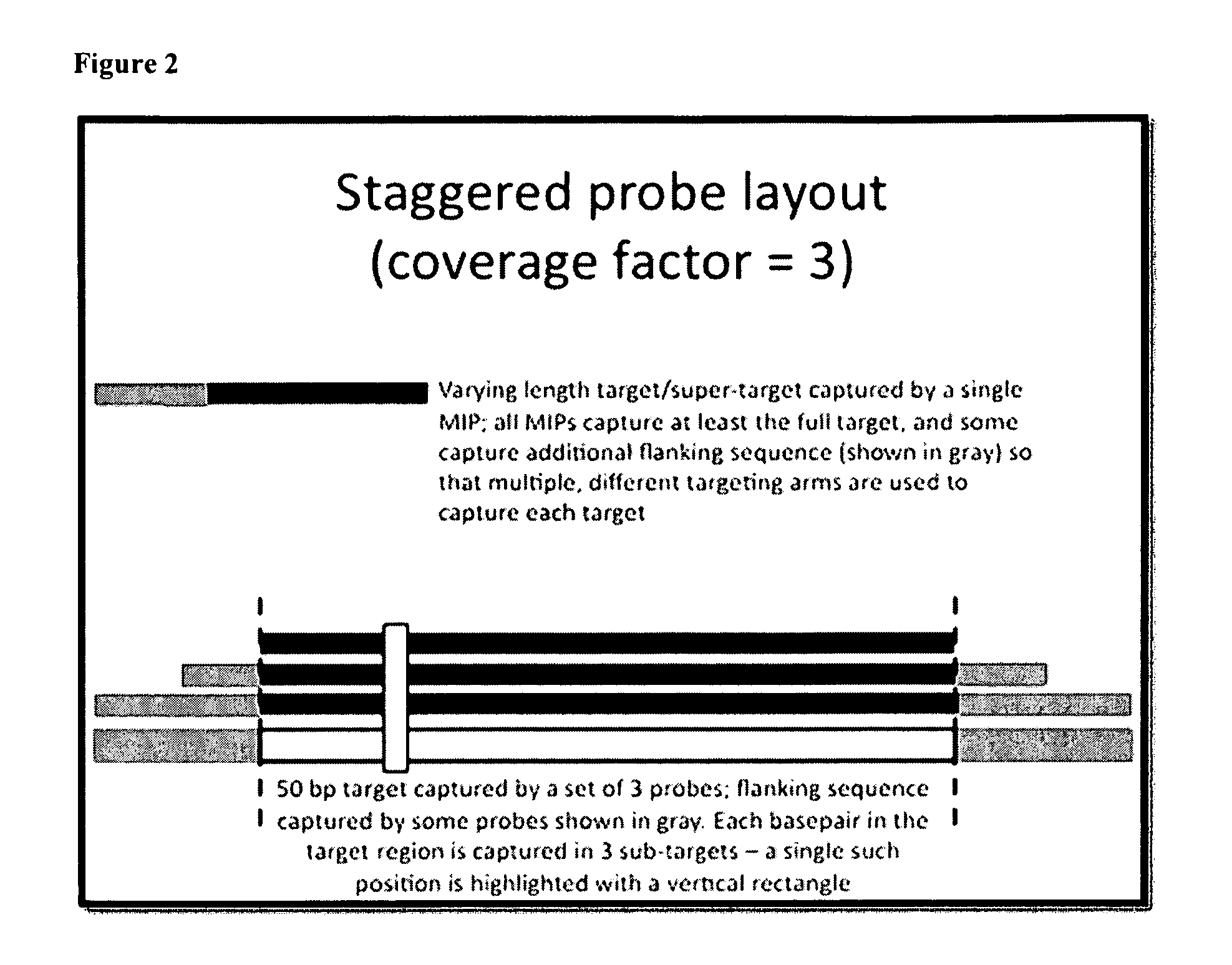Methods and compositions for evaluating genetic markers
a technology of genetic markers and compositions, applied in the field of methods and compositions for determining genotypes, can solve problems such as ambiguity and problems, and achieve the effects of reducing errors, high variability in the capture and amplification of nucleic acids, and disproportionate representation of heterozygous alleles
- Summary
- Abstract
- Description
- Claims
- Application Information
AI Technical Summary
Benefits of technology
Problems solved by technology
Method used
Image
Examples
example 1
Design a Set of Capture Probes for a Human Target Exon
[0211]All targets are captured as a set of partially-overlapping subtargets. For example, in the tiling approach, a 200 bp target exon might be captured as a set of 12 subtargets, each 60 bp in length (FIG. 1). Each subtarget is chosen such that it partially overlaps two or three other targets.
[0212]In some embodiments, all probes are composed of three regions: 1) a 20 bp ‘targeting arm’ comprised of sequence which hybridizes immediately upstream from the sub-target, 2) a 30 bp ‘constant region’ comprised of sequence used as a pair of amplification priming sites, and 3) a second 20 bp ‘targeting arm’ comprised of sequence which hybridizes immediately downstream from the sub-target. Targeting arm sequences will be different for each capture probe in a set, while constant region sequence will be the same for all probes in the set, allowing all captured targets to be amplified with a single set of primers. Targeting arm sequences sh...
example 2
Use of Differentiator Tag Sequences to Detect and Correct Bias in a MIP-Capture Reaction of a Set of Exon Targets
[0253]The first step in performing the detection / correction is to determine how many differentiator tag sequences are necessary for the given sample. In this example, 1000 genomic targets corresponding to 1000 exons were captured. Since the differentiator tag sequence is part of the probe, it will measure / report biases that occur from the earliest protocol steps. Also, being located in the backbone, the differentiator tag sequence can easily be sequenced from a separate priming site, and therefore not impact the total achievable read-length for the target sequence. MIP probes are synthesized using standard column-based oligonucleotide synthesis by any number of vendors (e.g. IDT), and differentiator tag sequences are introduced as ‘degenerate’ positions in the backbone. Each degenerate position increases the total number of differentiator tag sequences synthesized by a fa...
example 3
Differentiator Tag Sequence Design for MIP Capture Reactions
[0299]For a set of targets, the number of differentiator tag sequences necessary to be confident (within some statistical bounds) that a certain differentiator tag sequence will not be observed more than once by chance in combination with a certain target sequence was determined. The total number of unique differentiator tag sequences for a certain differentiator tag sequence length is determined as 4(Length in nucleotides of the differentiator tag sequence). For a molecular inversion probe capture reaction that uses MIP probes having differentiator tag sequences, the probability of performing the capture reaction and capturing one or more copies of a target sequence having the same differentiator tag sequence is calculated as: p=1−[N! / (N−M)!] / [N̂M], wherein N is the total number of possible unique differentiator tag sequences and M is the number of target sequence copies in the capture reaction. Thus, by varying the differ...
PUM
| Property | Measurement | Unit |
|---|---|---|
| Tm | aaaaa | aaaaa |
| Tm | aaaaa | aaaaa |
| Tm | aaaaa | aaaaa |
Abstract
Description
Claims
Application Information
 Login to View More
Login to View More - R&D
- Intellectual Property
- Life Sciences
- Materials
- Tech Scout
- Unparalleled Data Quality
- Higher Quality Content
- 60% Fewer Hallucinations
Browse by: Latest US Patents, China's latest patents, Technical Efficacy Thesaurus, Application Domain, Technology Topic, Popular Technical Reports.
© 2025 PatSnap. All rights reserved.Legal|Privacy policy|Modern Slavery Act Transparency Statement|Sitemap|About US| Contact US: help@patsnap.com



